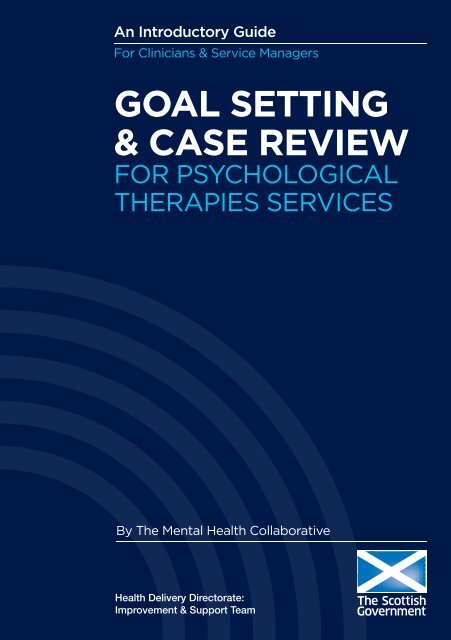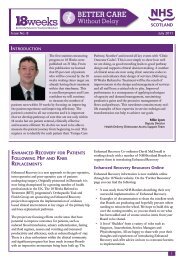Goal Setting & Case Review for Psychological Therapies Services
Goal Setting & Case Review for Psychological Therapies Services
Goal Setting & Case Review for Psychological Therapies Services
Create successful ePaper yourself
Turn your PDF publications into a flip-book with our unique Google optimized e-Paper software.
An Introductory Guide<br />
For Clinicians & Service Managers<br />
GOAL SETTING<br />
& CASE REVIEW<br />
FOR PSYCHOLOGICAL<br />
THERAPIES SERVICES<br />
By The Mental Health Collaborative
01/02<br />
Introduction<br />
This guide provides a basic<br />
introduction to goal setting<br />
and case review. It is part of a<br />
series of introductory guides<br />
<strong>for</strong> psychological therapies<br />
services. These guides cover<br />
four areas: Demand, Capacity,<br />
<strong>Goal</strong> <strong>Setting</strong> & <strong>Case</strong> <strong>Review</strong><br />
and Clinical Administration.<br />
There is also an introductory<br />
guide called ‘Start Here’ that<br />
looks at how to implement<br />
change in the midst of<br />
uncertainty about what<br />
will work.
<strong>Goal</strong> setting and case review are crucial aspects<br />
of managing demand in psychological therapies<br />
services. In any service it is important to be clear<br />
about the goals of the intervention. They need<br />
to be achievable and should match as closely as<br />
possible both the identified needs of the patient<br />
and their expectations.<br />
Improving our ability to set appropriate treatment<br />
goals, building in case review, and reviewing<br />
existing case loads will notably improve the<br />
efficiency of our service and the treatment of our<br />
patients.<br />
Some may say that the goal setting approach only<br />
works with a CBT treatment model. Certainly, the<br />
method and language used fit well with a CBT<br />
model. But all therapeutic interventions could<br />
reasonably be expected to set clearly defined<br />
and measurable goals, albeit using a different<br />
framework or language.<br />
For the purposes of these guides, a <strong>Psychological</strong><br />
Therapy Service is any local service providing<br />
psychological therapies. Examples might include:<br />
Primary Care Mental Health Teams, Community<br />
Mental Health Teams, Clinical Psychology Service<br />
and <strong>Psychological</strong> <strong>Therapies</strong> <strong>Services</strong>.
03/04<br />
<strong>Goal</strong> <strong>Setting</strong><br />
It is not unusual <strong>for</strong> people to be referred <strong>for</strong><br />
psychological therapy when the identified need<br />
may not be best met by therapy. For example,<br />
someone whose psychological distress is the result<br />
of notable debt problems, may need help from a<br />
specialist debt advice service.<br />
Often people have high and unrealistic<br />
expectations of what can be achieved with<br />
psychological therapy. Understandable and normal<br />
reactions to events such as bereavement are<br />
not likely to need, or benefit from, psychological<br />
therapy. A person’s goal of not experiencing a<br />
feeling of loss would not match the likely outcome<br />
of psychological therapy.<br />
It is also important to consider the expectations of<br />
referrers and patients with respect to the goals of<br />
different levels of service. A brief guided-self help<br />
programme with a limit of three sessions, a stress<br />
control class of 4 sessions, six brief counselling<br />
sessions, and sixteen High Intensity CBT contacts<br />
would all have their own limits on what was<br />
achievable.<br />
“”<br />
Often people have high and<br />
unrealistic expectations of<br />
what can be achieved with<br />
psychological therapy
<strong>Case</strong> <strong>Review</strong><br />
Monitoring and reviewing cases is an important<br />
part of our work as psychological therapists.<br />
It allows us to monitor progress towards a good<br />
outcome and check that our input/competency<br />
matches the needs of the patient.<br />
In practice many clinicians, especially the less<br />
experienced, greatly appreciate the learning they<br />
gain from regular case review. For case review to<br />
be effective:<br />
• this process should be non-threatening,<br />
supportive and used to in<strong>for</strong>m both the individual<br />
and the service about clinical issues that arise;<br />
• occur in supervision, as well as <strong>for</strong>ming part of<br />
a psychological therapist’s individual reflective<br />
practice;<br />
• allow the recording of in<strong>for</strong>mation that will help<br />
planning of training.<br />
From the operational point of view, there is a<br />
need to monitor the demand generated by each<br />
case and to compare this with predicted demand.<br />
There is also a need to monitor fit with service/<br />
team criteria. Regular recording and collation of<br />
service use in<strong>for</strong>mation should be an integral part<br />
of the service manager’s role. The Demand <strong>for</strong><br />
<strong>Psychological</strong> <strong>Therapies</strong> <strong>Services</strong> guide provides<br />
further in<strong>for</strong>mation on this.
<strong>Goal</strong> <strong>Setting</strong><br />
SMART Clinical Work<br />
One way of considering clinical interventions is to<br />
be SMART. For each patient we can ask ourselves<br />
a number of questions about the goals of the<br />
intervention.<br />
S.M.A.R.T. stands <strong>for</strong><br />
S<br />
Treatment goals should be specific<br />
M<br />
Therapist and patient should be able to<br />
measure whether they are meeting their<br />
goals<br />
A<br />
Are the goals set, achievable and<br />
attainable<br />
R<br />
Can you realistically achieve the goals<br />
with the resources you have (This will<br />
include therapist and patient resources,<br />
as well as the impact of external factors).<br />
T<br />
Have you set a time <strong>for</strong> achieving or<br />
reviewing the goals
SMART working<br />
Things to consider<br />
Q. What is a realistic amount of improvement<br />
A. It is worth considering what % improvement is realistic and<br />
possible, 80% improvement may well be enough to allow<br />
the patient to move <strong>for</strong>ward. Is it worth trying <strong>for</strong> a possibly<br />
unrealistic 100% improvement<br />
Q Does everything need to be addressed at once<br />
A. For complex presentations it may be appropriate to focus<br />
on goals that are likely to be achievable with the therapy<br />
available.<br />
Q Are there significant factors that serve as barriers to<br />
progress<br />
A. For some, the role of external factors and social stressors<br />
may act as a barrier to improvement. In such cases it may be<br />
more expedient to refer onwards <strong>for</strong> help with these issues<br />
be<strong>for</strong>e considering therapy.<br />
The resources, skills and abilities a patient brings to therapy<br />
are important contributing factors to their progress<br />
Q Do the patient and therapist share the goals<br />
A. Shared goals can be considered, regardless of the<br />
therapeutic model, to be important. Active participation in the<br />
therapeutic process is an important variable. Thus a shared<br />
view of goals and methods of treatment can be seen as<br />
essential to the establishment of a sound therapeutic alliance.<br />
Q Is the patient ready to change<br />
A. Change is a process that unfolds over time. Starting<br />
therapy be<strong>for</strong>e a patient is ready to make changes and<br />
undertake the work required to make progress is unlikely to<br />
succeed, and may be a significant cause of ‘drop-out’.
07/08<br />
<strong>Goal</strong> <strong>Setting</strong><br />
Starting SMART<br />
The best place to start SMART working is at<br />
the first assessment interview. This allows more<br />
accurate matching to the referral criteria <strong>for</strong> your<br />
service(s) than using referral letters.<br />
The initial assessment could have a solution<br />
focused aspect to it, building in discharge planning<br />
from the start. This may include:<br />
• Clarifying problem areas;<br />
• <strong>Setting</strong> SMART treatment goals;<br />
• Agreeing what is expected of therapist<br />
AND patient;<br />
• Identifying supporting activities that the patient<br />
can undertake in addition to the therapy;<br />
• Identifying and addressing potential barriers to<br />
progress.<br />
“”<br />
...the patient should be<br />
transferred to another<br />
therapist or service where<br />
there is a better match<br />
between competency<br />
and need.
<strong>Goal</strong> <strong>Setting</strong><br />
SMART Matching<br />
If you are working with a matched/stepped care<br />
model then it will be easier to be SMART. Once<br />
a case has been assessed it should be matched<br />
to the level of service most appropriate. This<br />
matching needs to include patient characteristics.<br />
For example, if guided self-help will involve reading<br />
and record keeping, a level of literacy will be<br />
required.<br />
<strong>Goal</strong> <strong>Setting</strong><br />
SMART Re<strong>for</strong>mulation<br />
It is not uncommon <strong>for</strong> the initial <strong>for</strong>mulation to<br />
be revised in the course of therapy. This may lead<br />
to revised SMART treatment goals and may mean<br />
that the patient should be transferred to another<br />
therapist or service where there is a better match<br />
between competency and need. In a stepped care<br />
model, this would be a transfer to a more intense/<br />
longer duration psychological therapy or a step<br />
down to guided self-help or practical support<br />
rather than active therapy.<br />
<strong>Goal</strong> <strong>Setting</strong><br />
SMART Stepping<br />
Stepping up or down should be arranged within<br />
a service and should happen as seamlessly as<br />
possible, without the need <strong>for</strong> a further referral that<br />
could lead to another wait <strong>for</strong> the patient.
09/10<br />
<strong>Case</strong> <strong>Review</strong><br />
Staying SMART<br />
A healthy psychological therapy service has a<br />
system that automatically builds case review into<br />
a patient’s journey. This would include:<br />
• Ensuring new cases meet referral criteria;<br />
• Building in discharge from the outset;<br />
• Contracting an initial number of sessions;<br />
• <strong>Setting</strong> a review date;<br />
• Revise aims/re<strong>for</strong>mulate if needed;<br />
• Not routinely offering ‘check up’ appointments;<br />
• Routinely monitoring and measuring caseload<br />
activity and manage.<br />
Application Tip<br />
The Wiseman Workload<br />
Measure (WWM) is<br />
one tool that can help<br />
you with caseload<br />
management.<br />
The WWM measures<br />
actual and total<br />
workload. Within the<br />
tool total workload is<br />
defined as ‘Direct Care,<br />
Indirect Care, Role/<br />
Agency Tasks and<br />
Travel.<br />
The Measure also<br />
features a Turnover<br />
and Time on <strong>Case</strong>load<br />
Monitor. The WWM is<br />
completed by individual<br />
practitioners but can be<br />
aggregated to represent<br />
team and service<br />
total activity and total<br />
capacity.<br />
For further in<strong>for</strong>mation<br />
please see: www.<br />
scotland.gov.uk/<br />
Topics/Health/NHS-<br />
Scotland/Delivery-<br />
Improvement/1835/74
<strong>Case</strong> <strong>Review</strong><br />
Detox <strong>for</strong> psychological therapy services<br />
Most psychological therapy services gradually<br />
build up a number of cases that are not achieving<br />
good outcomes or seem ‘stuck’. This can lead<br />
to reduced capacity, as well as frustrated and<br />
demoralised patients and therapists.<br />
It is a good idea to have a regular team case review<br />
session, at least twice a year. Team members<br />
should bring along all cases that have exceeded<br />
an agreed number of sessions, or where they are<br />
feeling ‘stuck’.<br />
A case review checklist can be useful to help the<br />
review run smoothly. See below <strong>for</strong> an example of a<br />
checklist. This can be used in individual supervision<br />
as well as team reviews. Local area teams may<br />
wish to add more specific questions and criteria to<br />
match their service profile and competency mix.<br />
If cases are being seen because there is no suitable<br />
alternative, despite not meeting team criteria,<br />
this can be a good opportunity to identify and<br />
specify gaps in supporting services/agencies. The<br />
in<strong>for</strong>mation can be used to clarify unmet need and<br />
gaps in services that can be used to in<strong>for</strong>m future<br />
planning.<br />
As the team will know their capacity, it is possible<br />
to quantify the impact of increasing alternative<br />
services on the capacity of the team. In some cases<br />
this could be costed and allow <strong>for</strong> a well made<br />
business case <strong>for</strong> increasing alternative service<br />
provision.
11/12<br />
Staying <strong>Case</strong><br />
<strong>Review</strong> Checklist<br />
The following is an example of a checklist that<br />
could be used by clinicians on their own, or in<br />
supervision.<br />
The language used may not suit the therapy<br />
model, and not all points may be relevant. It is the<br />
concept of a systematic, goal orientated review<br />
that is important.<br />
A checklist will work best if the clinical staff in<br />
the service have contributed to its development.<br />
Different levels and types of services will require<br />
different review checklists.
Questions<br />
Does the case meet<br />
service criteria<br />
What are the aims<br />
of therapy Are they<br />
SMART Will you know<br />
when they have been<br />
achieved<br />
Have you checked<br />
progress against aims<br />
If aims met but problems<br />
remain, have you<br />
re<strong>for</strong>mulated<br />
Do they need your level<br />
of skill Could someone<br />
else do the work<br />
Do they still need the<br />
service<br />
Is there a follow-up<br />
appointment – if yes is it<br />
necessary<br />
Could the follow-up be<br />
by phone<br />
Are there dependency<br />
issues<br />
Are you ‘worried’ that<br />
they have nothing else<br />
Are there attendance<br />
problems Is the DNA<br />
policy clear to the<br />
patient and is it being<br />
applied<br />
Yes/No<br />
Action<br />
planned By whom By when
Summary<br />
The following checklist will help you decide<br />
whether you are making effective use of your<br />
current capacity. Rather than a simple yes/no<br />
choice you can select ‘partly’, as we recognise<br />
that most services will be in the process of looking<br />
more closely at what they are doing.<br />
If you can answer yes to every question in this<br />
checklist, then you are probably doing everything<br />
you can to make the most effective use of your<br />
current capacity. If you answer no or partly to<br />
questions, then this indicates an area where you<br />
could do further work.
<strong>Goal</strong> <strong>Setting</strong> and <strong>Case</strong> <strong>Review</strong> Yes Partly No<br />
Are all cases checked <strong>for</strong> match to<br />
service criteria<br />
Does the service use a goal setting<br />
approach<br />
• Are the goals of therapy explicit<br />
• Are the goals S.M.A.R.T.<br />
Is there a seamless system <strong>for</strong><br />
stepping up/down to services that<br />
best match goals<br />
Is there a system of case review<br />
built into supervision<br />
Do you regularly review case loads<br />
against treatment and service<br />
goals<br />
Do you regularly check progress<br />
against aims<br />
Is there a good match between<br />
level of skill and identified needs<br />
Are there flexible arrangements<br />
possible <strong>for</strong> follow-up<br />
appointments<br />
Are there systems to deal with<br />
dependency issues<br />
Is the DNA policy clear and is it<br />
being applied
© Crown Copyright 2010<br />
These booklets have been produced by the Scottish Mental Health<br />
Collaborative. For further in<strong>for</strong>mation about the work of the Scottish<br />
Mental Health Collaborative please visit its website:<br />
www.scotland.gov.uk/<strong>Psychological</strong><strong>Therapies</strong><strong>Services</strong>IntroductoryGuides/<br />
<strong>Goal</strong><strong>Setting</strong>sand<strong>Case</strong><strong>Review</strong><br />
These booklets are a series of five. These are listed below:<br />
• Improving Access to <strong>Psychological</strong> <strong>Therapies</strong> <strong>Services</strong><br />
• Capacity <strong>for</strong> <strong>Psychological</strong> <strong>Therapies</strong> <strong>Services</strong><br />
• Demand <strong>for</strong> <strong>Psychological</strong> <strong>Therapies</strong> <strong>Services</strong><br />
• Clinical Administration <strong>for</strong> <strong>Psychological</strong> <strong>Therapies</strong> <strong>Services</strong><br />
• <strong>Goal</strong> <strong>Setting</strong> & <strong>Case</strong> <strong>Review</strong> <strong>for</strong> <strong>Psychological</strong> <strong>Therapies</strong> <strong>Services</strong><br />
PDF copies of these booklets can be assessed at the<br />
Scottish Government website: www.scotland.gov.uk<br />
APS Group Scotland<br />
DPPAS10063 05/10<br />
ISBN: 978-0-7559-9346-8<br />
Further copies are available from:<br />
BookSource<br />
50 Cambuslang Road<br />
Cambuslang Investment Park<br />
Glasgow G32 8NB<br />
Telephone: 0845-370-0067<br />
Fax: 0845-370-0068<br />
Email: scottishgovernment@booksource.net<br />
9 780755 993468
















